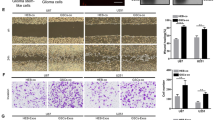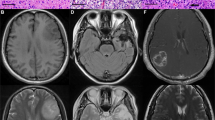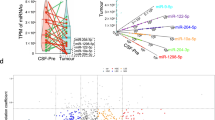Abstract
Glioblastoma (GBM) is known as a tumor type, which arises from astrocytes. Several studies indicated that GBM tumor cells are malignant. This is because of the fact that they consist of different cell types, which are reproducing very quickly and are also supported by a large network of blood vessels. The correct identification of various stages of GBM could help to better treat the patients with this disease. Therefore, new biomarkers such as exosomes and microRNAs (miRNAs) may help us to learn more about GBM and they may also lead to a more effective treatment for patients with GBM. Exosomes have emerged as biological vehicles, which can perform various tasks in carcinogenesis pathways such as PI3K/AKT, SOX2, PTEN, ERK, and STAT3. The miRNAs are known as small noncoding RNAs that are involved in several GBM pathogenic events. These molecules have key roles in various biological processes such as angiogenesis, metastasis and tumor growth. In this study, we highlighted various exosomes and miRNAs that could be used for diagnosis and/or prognosis biomarkers in patients with GBM.
This is a preview of subscription content, access via your institution
Access options
Subscribe to this journal
Receive 12 print issues and online access
$259.00 per year
only $21.58 per issue
Buy this article
- Purchase on Springer Link
- Instant access to full article PDF
Prices may be subject to local taxes which are calculated during checkout

Similar content being viewed by others
References
Qiu S, Lin S, Hu D, Feng Y, Tan Y, Peng Y . Interactions of miR-323/miR-326/miR-329 and miR-130a/miR-155/miR-210 as prognostic indicators for clinical outcome of glioblastoma patients. J Transl Med 2013; 11: 1.
la Iglesia Nd, Puram SV, Bonni A . STAT3 regulation of glioblastoma pathogenesis. Curr Mol Med 2009; 9: 580–590.
Cloughesy TF, Cavenee WK, Mischel PS . Glioblastoma: from molecular pathology to targeted treatment. Annu Rev Pathol 2014; 9: 1–25.
Caspani EM, Crossley PH, Redondo-Garcia C, Martinez S . Glioblastoma: a pathogenic crosstalk between tumor cells and pericytes. PloS One 2014; 9: e101402.
Møller HG, Rasmussen AP, Andersen HH, Johnsen KB, Henriksen M, Duroux M . A systematic review of microRNA in glioblastoma multiforme: micro-modulators in the mesenchymal mode of migration and invasion. Mol Neurobiol 2013; 47: 131–144.
Ciafre S, Galardi S, Mangiola A, Ferracin M, Liu C-G, Sabatino G et al. Extensive modulation of a set of microRNAs in primary glioblastoma. Biochem Biophy Res Commun 2005; 334: 1351–1358.
Novakova J, Slaby O, Vyzula R, Michalek J . MicroRNA involvement in glioblastoma pathogenesis. Biochem Biophys Res Commun 2009; 386: 1–5.
Lakomy R, Sana J, Hankeova S, Fadrus P, Kren L, Lzicarova E et al. MiR‐195, miR‐196b, miR‐181c, miR‐21 expression levels and O‐6‐methylguanine‐DNA methyltransferase methylation status are associated with clinical outcome in glioblastoma patients. Cancer Sci 2011; 102: 2186–2190.
Valadi H, Ekström K, Bossios A, Sjöstrand M, Lee JJ, Lötvall JO . Exosome-mediated transfer of mRNAs and microRNAs is a novel mechanism of genetic exchange between cells. Nat Cell Biol 2007; 9: 654–659.
Houseley J, LaCava J, Tollervey D . RNA-quality control by the exosome. Nat Rev Mol Cell Biol 2006; 7: 529–539.
Hoshino A, Costa-Silva B, Shen T-L, Rodrigues G, Hashimoto A, Mark MT et al. Tumour exosome integrins determine organotropic metastasis. Nature 2015; 527: 329–335.
Thoms M, Thomson E, Baßler J, Gnädig M, Griesel S, Hurt E . the exosome is recruited to RNA substrates through specific adaptor proteins. Cell 2015; 162: 1029–1038.
Nilsson J, Skog J, Nordstrand A, Baranov V, Mincheva-Nilsson L, Breakefield X et al. Prostate cancer-derived urine exosomes: a novel approach to biomarkers for prostate cancer. Br J Cancer 2009; 100: 1603–1607.
Miranda KC, Bond DT, McKee M, Skog J, Păunescu TG, Da Silva N et al. Nucleic acids within urinary exosomes/microvesicles are potential biomarkers for renal disease. Kidney Int 2010; 78: 191–199.
Alvarez ML, Khosroheidari M, Ravi RK, DiStefano JK . Comparison of protein, microRNA, and mRNA yields using different methods of urinary exosome isolation for the discovery of kidney disease biomarkers. Kidney Int 2012; 82: 1024–1032.
Seow Y, Wood MJ . Biological gene delivery vehicles: beyond viral vectors. Mol Ther 2009; 17: 767–777.
Bellingham SA, Guo B, Coleman B, Hill AF . Exosomes: vehicles for the transfer of toxic proteins associated with neurodegenerative diseases? Front Physiol 2012; 3: 124.
Tan A, Rajadas J, Seifalian AM . Exosomes as nano-theranostic delivery platforms for gene therapy. Adv Drug Deliv Rev 2013; 65: 357–367.
Guescini M, Genedani S, Stocchi V, Agnati LF . Astrocytes and glioblastoma cells release exosomes carrying mtDNA. J Neural Transm 2010; 117: 1–4.
Munoz JL, Bliss SA, Greco SJ, Ramkissoon SH, Ligon KL, Rameshwar P . Delivery of functional anti-miR-9 by mesenchymal stem cell–derived exosomes to glioblastoma multiforme cells conferred chemosensitivity. Mol Ther Nucleic Acids 2013; 2: e126.
Shao H, Chung J, Lee K, Balaj L, Min C, Carter BS et al. Chip-based analysis of exosomal mRNA mediating drug resistance in glioblastoma. Nat Commun 2015; 6: 6999.
Keller S, Ridinger J, Rupp A-K, Janssen JW, Altevogt P . Body fluid derived exosomes as a novel template for clinical diagnostics. J Transl Med 2011; 9: 1.
Arscott WT, Tandle AT, Zhao S, Shabason JE, Gordon IK, Schlaff CD et al. Ionizing radiation and glioblastoma exosomes: implications in tumor biology and cell migration. Transl Oncol 2013; 6: 638–IN6.
Cheshmi H . Glioblastoma microvesicles transport RNA and proteins that promote tumour growth and provide diagnostic biomarkers. New Cell Mol Biotechnol J 2011; 1: 75–88.
Akers JC, Ramakrishnan V, Kim R, Skog J, Nakano I, Pingle S et al. MiR-21 in the extracellular vesicles (EVs) of cerebrospinal fluid (CSF): a platform for glioblastoma biomarker development. PloS One 2013; 8: e78115.
Shao H, Chung J, Balaj L, Charest A, Bigner DD, Carter BS et al. Protein typing of circulating microvesicles allows real-time monitoring of glioblastoma therapy. Nat Med 2012; 18: 1835–1840.
Gholamin S, Pasdar A, Sadegh Khorrami M, Mirzaei H, Reza Mirzaei H, Salehi R et al. The potential for circulating microRNAs in the diagnosis of myocardial infarction: a novel approach to disease diagnosis and treatment. Curr Pharm Des 2016; 22: 397–403.
Mirzaei H, Naseri G, Rezaee R, Mohammadi M, Banikazemi Z, Reza Mirzaei H et al. Curcumin: a new candidate for melanoma therapy? Int J Cancer 2016; 139: 1683–1695.
Mirzaei H, Sahebkar A, Yazdi F, Salehi H, Jafari M, Namdar A et al. Circulating microRNAs in hepatocellular carcinoma: potential diagnostic and prognostic biomarkers. Curr Pharm Des 2016 (e-pub ahead of print: 2 March 2016).
Mirzaei H, Gholamin S, Shahidsales S, Sahebkar A, Jafaari MR, Mirzaei HR et al. MicroRNAs as potential diagnostic and prognostic biomarkers in melanoma. Eur J Cancer 2016; 53: 25–32.
Simonian M, Mosallayi M, Mirzaei H . Circulating miR-21 as novel biomarker in gastric cancer: diagnostic and prognostic biomarker. J Cancer Res Ther 2016 (e-pub ahead of print).
Salarini R, Sahebkar A, Mirzaei H, Jaafari M, Riahi M, Hadjati J et al. Epi-drugs and epi-miRs: moving beyond current cancer therapies. Curr Cancer Drug Targets 2015 (e-pub ahead of print 6 December 2015).
Wu Z, Sun L, Wang H, Yao J, Jiang C, Xu W et al. MiR-328 expression is decreased in high-grade gliomas and is associated with worse survival in primary glioblastoma. PloS One 2012; 7: e47270.
Wang Q, Li P, Li A, Jiang W, Wang H, Wang J et al. Plasma specific miRNAs as predictive biomarkers for diagnosis and prognosis of glioma. Journal of Experimental &. Clin Cancer Res 2012; 31: 1.
Chen L, Zhang A, Li Y, Zhang K, Han L, Du W et al. MiR-24 regulates the proliferation and invasion of glioma by ST7L via β-catenin/Tcf-4 signaling. Cancer Lett 2013; 329: 174–180.
Silber J, Lim DA, Petritsch C, Persson AI, Maunakea AK, Yu M et al. miR-124 and miR-137 inhibit proliferation of glioblastoma multiforme cells and induce differentiation of brain tumor stem cells. BMC Med 2008; 6: 1.
Tan X, Wang S, Yang B, Zhu L, Yin B, Chao T et al. The CREB-miR-9 negative feedback minicircuitry coordinates the migration and proliferation of glioma cells. PloS One 2012; 7: e49570.
Tang H, Liu X, Wang Z, She X, Zeng X, Deng M et al. Interaction of hsa-miR-381 and glioma suppressor LRRC4 is involved in glioma growth. Brain Res 2011; 1390: 21–32.
Guessous F, Alvarado-Velez M, Marcinkiewicz L, Zhang Y, Kim J, Heister S et al. Oncogenic effects of miR-10b in glioblastoma stem cells. J Neuro Oncol 2013; 112: 153–163.
Chaudhry MA, Sachdeva H, Omaruddin RA . Radiation-induced micro-RNA modulation in glioblastoma cells differing in DNA-repair pathways. DNA Cell Biol 2010; 29: 553–561.
Tan X, Wang S, Zhu L, Wu C, Yin B, Zhao J et al. cAMP response element-binding protein promotes gliomagenesis by modulating the expression of oncogenic microRNA-23a. Proc Natl Acad Sci 2012; 109: 15805–15810.
Chen L, Han L, Zhang K, Shi Z, Zhang J, Zhang A et al. VHL regulates the effects of miR-23b on glioma survival and invasion via suppression of HIF-1α/VEGF and β-catenin/Tcf-4 signaling. Neuro Oncol 2012; 14: 1026–1036.
Ying Z, Li Y, Wu J, Zhu X, Yang Y, Tian H et al. Loss of miR-204 expression enhances glioma migration and stem cell-like phenotype. Cancer Res 2013; 73: 990–999.
Zhang C-Z, Zhang J-X, Zhang A-L, Shi Z-D, Han L, Jia Z-F et al. MiR-221 and miR-222 target PUMA to induce cell survival in glioblastoma. Mol Cancer 2010; 9: 1.
Wu N, Xiao L, Zhao X, Zhao J, Wang J, Wang F et al. miR‐125b regulates the proliferation of glioblastoma stem cells by targeting E2F2. FEBS Lett. 2012; 586: 3831–3839.
Wang K, Wang X, Zou J, Zhang A, Wan Y, Pu P et al. miR-92b controls glioma proliferation and invasion through regulating Wnt/beta-catenin signaling via Nemo-like kinase. Neuro Oncol 2013; 15: 578–588.
Sana J, Hajduch M, Michalek J, Vyzula R, Slaby O . MicroRNAs and glioblastoma: roles in core signalling pathways and potential clinical implications. J Cell Mol Med 2011; 15: 1636–1644.
Delic S, Lottmann N, Stelzl A, Liesenberg F, Wolter M, Götze S et al. MiR-328 promotes glioma cell invasion via SFRP1-dependent Wnt-signaling activation. Neuro Oncology 2013; 16: 179–190.
Xu X, Xu Q, Tong J, Zhu M, Nie F, Chen X et al. MicroRNA expression profiling identifies miR-328 regulates cancer stem cell-like SP cells in colorectal cancer. Br J Cancer 2012; 106: 1320–1330.
Huse JT, Brennan C, Hambardzumyan D, Wee B, Pena J, Rouhanifard SH et al. The PTEN-regulating microRNA miR-26a is amplified in high-grade glioma and facilitates gliomagenesis in vivo. Genes Dev 2009; 23: 1327–1337.
Gal H, Pandi G, Kanner AA, Ram Z, Lithwick-Yanai G, Amariglio N et al. MIR-451 and Imatinib mesylate inhibit tumor growth of Glioblastoma stem cells. Biochem Biophys Res Commun 2008; 376: 86–90.
Koo S, Martin GS, Schulz KJ, Ronck M, Toussaint LG . Serial selection for invasiveness increases expression of miR-143/miR-145 in glioblastoma cell lines. BMC Cancer 2012; 12: 1.
Yang G, Zhang R, Chen X, Mu Y, Ai J, Shi C et al. MiR-106a inhibits glioma cell growth by targeting E2F1 independent of p53 status. J Mol Med 2011; 89: 1037–1050.
Chen L, Zhang J, Feng Y, Li R, Sun X, Du W et al. MiR-410 regulates MET to influence the proliferation and invasion of glioma. Int J Biochem Cell Biol 2012; 44: 1711–1717.
Xia H, Qi Y, Ng SS, Chen X, Chen S, Fang M et al. MicroRNA-15b regulates cell cycle progression by targeting cyclins in glioma cells. Biochem Biophys Res Commun 2009; 380: 205–210.
Zheng X, Chopp M, Lu Y, Buller B, Jiang F . MiR-15b and miR-152 reduce glioma cell invasion and angiogenesis via NRP-2 and MMP-3. Cancer Lett 2013; 329: 146–154.
Ujifuku K, Mitsutake N, Takakura S, Matsuse M, Saenko V, Suzuki K et al. MiR-195, miR-455-3p and miR-10a∗ are implicated in acquired temozolomide resistance in glioblastoma multiforme cells. Cancer Lett 2010; 296: 241–248.
Haghikia A, Haghikia A, Hellwig K, Baraniskin A, Holzmann A, Décard BF et al. Regulated microRNAs in the CSF of patients with multiple sclerosis a case-control study. Neurology 2012; 79: 2166–2170.
Yang Y, Wu J, Guan H, Cai J, Fang L, Li J et al. MiR‐136 promotes apoptosis of glioma cells by targeting AEG‐1 and Bcl‐2. FEBS Lett 2012; 586: 3608–3612.
Kim J, Zhang Y, Skalski M, Hayes J, Kefas B, Schiff D et al. microRNA-148a is a prognostic oncomiR that targets MIG6 and BIM to regulate EGFR and apoptosis in glioblastoma. Cancer Res 2014; 74: 1541–1553.
Jeansonne D, Pacifici M, Lassak A, Reiss K, Russo G, Zabaleta J et al. Differential effects of microRNAs on glioblastoma growth and migration. Genes 2013; 4: 46–64.
Li X, Liu Y, Granberg KJ, Wang Q, Moore LM, Ji P et al. Two mature products of MIR-491 coordinate to suppress key cancer hallmarks in glioblastoma. Oncogene 2015; 34: 1619–1628.
Yan W, Zhang W, Sun L, Liu Y, You G, Wang Y et al. Identification of MMP-9 specific microRNA expression profile as potential targets of anti-invasion therapy in glioblastoma multiforme. Brain Res 2011; 1411: 108–115.
Wang L, Shi M, Hou S, Ding B, Liu L, Ji X et al. MiR‐483–5p suppresses the proliferation of glioma cells via directly targeting ERK1. FEBS Lett 2012; 586: 1312–1317.
Kefas B, Godlewski J, Comeau L, Li Y, Abounader R, Hawkinson M et al. microRNA-7 inhibits the epidermal growth factor receptor and the Akt pathway and is down-regulated in glioblastoma. Cancer Res 2008; 68: 3566–3572.
Slaby O, Svoboda M, Fabian P, Smerdova T, Knoflickova D, Bednarikova M et al. Altered expression of miR-21, miR-31, miR-143 and miR-145 is related to clinicopathologic features of colorectal cancer. Oncology 2008; 72: 397–402.
Suh S-S, Yoo JY, Nuovo GJ, Jeon Y-J, Kim S, Lee TJ et al. MicroRNAs/TP53 feedback circuitry in glioblastoma multiforme. Proc Natl Acad Sci 2012; 109: 5316–5321.
Smits M, Nilsson J, Mir SE, van der Stoop PM, Hulleman E, Niers JM et al. miR-101 is down-regulated in glioblastoma resulting in EZH2-induced proliferation, migration, and angiogenesis. Oncotarget 2011; 1: 710–720.
Guessous F, Zhang Y, Kofman A, Catania A, Li Y, Schiff D et al. microRNA-34a is tumor suppressive in brain tumors and glioma stem cells. Cell Cycle 2010; 9: 1031–1036.
Papagiannakopoulos T, Friedmann-Morvinski D, Neveu P, Dugas J, Gill R, Huillard E et al. Pro-neural miR-128 is a glioma tumor suppressor that targets mitogenic kinases. Oncogene 2012; 31: 1884–1895.
Wei J, Wang F, Kong L-Y, Xu S, Doucette T, Ferguson SD et al. MiR-124 inhibits STAT3 signaling to enhance T cell–mediated immune clearance of glioma. Cancer Res 2013; 73: 3913–3926.
Yao Y, Xue Y, Ma J, Shang C, Wang P, Liu L et al. MiR-330-mediated regulation of SH3GL2 expression enhances malignant behaviors of glioblastoma stem cells by activating ERK and PI3K/AKT signaling pathways. PloS One 2014; 9: e95060.
Author information
Authors and Affiliations
Corresponding author
Ethics declarations
Competing interests
The authors declare no conflict of interest.
Rights and permissions
About this article
Cite this article
Saadatpour, L., Fadaee, E., Fadaei, S. et al. Glioblastoma: exosome and microRNA as novel diagnosis biomarkers. Cancer Gene Ther 23, 415–418 (2016). https://doi.org/10.1038/cgt.2016.48
Received:
Revised:
Accepted:
Published:
Issue Date:
DOI: https://doi.org/10.1038/cgt.2016.48
This article is cited by
-
Identification of miR-143-3p as a diagnostic biomarker in gastric cancer
BMC Medical Genomics (2023)
-
Exosome-based nanoimmunotherapy targeting TAMs, a promising strategy for glioma
Cell Death & Disease (2023)
-
miR-1297 sensitizes glioma cells to temozolomide (TMZ) treatment through targeting adrenomedullin (ADM)
Journal of Translational Medicine (2022)
-
Circular RNAs and glioblastoma multiforme: focus on molecular mechanisms
Cell Communication and Signaling (2022)
-
Role of exosomes in the pathogenesis, diagnosis, and treatment of central nervous system diseases
Journal of Translational Medicine (2022)



